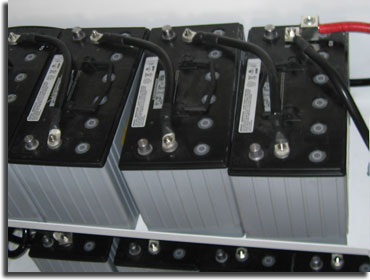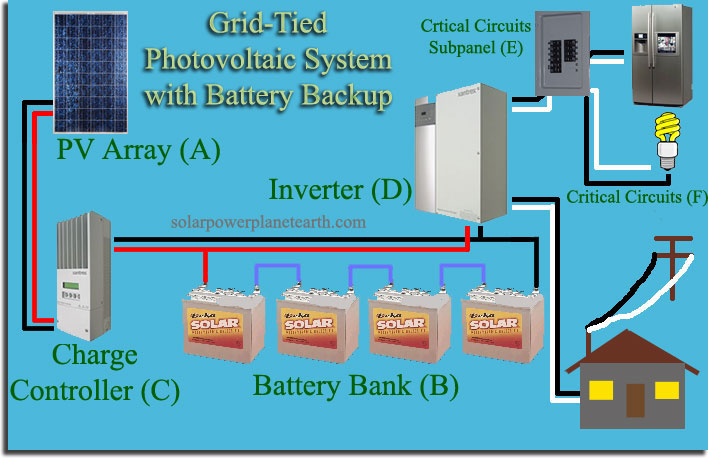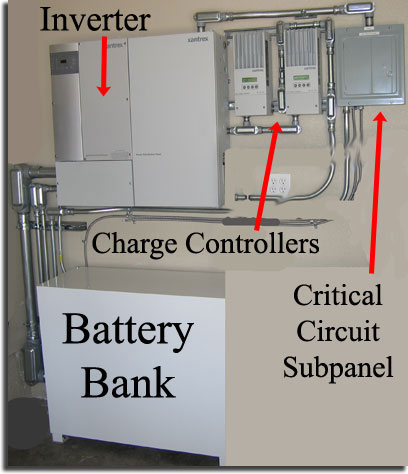 |
Grid-Tie Solar System with Battery Backup
In a normal grid-tied solar system, if the grid goes down for any reason, so does your solar system. We also know that in an off-grid solar system, we can power our entire home with a bank of deep-cycle batteries. Want the best of both worlds? The solution is a grid-tied solar system with backup power, or more commonly known as a "hybrid solar system." Backup power can come from a battery bank, or some type of backup generator. The battery bank does not need to be as large as in the case of an off-grid system, since it can be set up to only power "critical" loads, such as your refrigerator and lights. Here is the general layout of a hybrid solar system:

(A) Photovoltaic Array
The solar contractor will size your array to offset the desired percentage of electrical power you use. Contrary to an off-grid solar system, your array does not have to be sized with cloudy days taken into account, since your battery backup is only for a small number of "critical circuits."
(B) Battery Bank
The battery bank in this case is sized to meet the need of a set of loads which are deemed to be "critical," that shall remained powered in the event the grid goes down. More on how to choose your critical circuits in the paragraphs below. In the event of a grid power failure, these deep cycle batteries which are re-charged during the day with the solar panels, will provide power to your critical circuits 24 hours a day, indefinitely. Remember, only circuits which are hooked into your critical circuits sub panel will receive power during an outage, everything else will be down until the grid comes back up.
(C) Charge Controller
As in the case of an off-grid solar system, the charge controller regulates the charge cycle of the batteries to maximize their life. Once the batteries are fully charged, any excess power your solar array produces is back fed into the grid through your inverter, earning you credits with the utility company, in the same manner a standard grid-tied solar system does. More than one charge controller may be needed depending on the size of the solar array. An example of this is shown in the photo below.
(D) Inverter
A hybrid solar system inverter is slightly more complex than an inverter that would be used for a standard grid-tied solar system. This inverter must not only invert and have the ability to back-feed power into the grid, but also invert from a battery bank, power a critical circuit sub panel, and in some cases allow charging of the battery bank using power from the grid also. If the inverter can also charge the battery bank using power from the grid, it is known as an inverter/charger. Most of these higher end inverters, also have an input for a backup generator, if that is desired instead of a battery bank.
(E) Critical Circuit Sub Panel
This panel will contain all the circuit breakers which lead to your critical circuit loads. These loads will always have power, regardless of grid status. It is important to note, that in "back-up" mode, power will only be drawn from your battery array in the event of a grid failure. Some inverters allow you to setup your system to offset power during peak power demand by drawing power from your batteries, however, this is not part of having a "back-up" system, just an additional feature offered by certain manufactures.
(F) Critical Circuits
This set of critical loads can be anything the user wants, such as a refrigerator, lighting, security systems, etc. Just remember, the more loads you place in the critical path, the larger your battery array will have to be to supply power in the event of a grid failure.
A hybrid solar power system is not as common due to the significant increase in total cost, which ultimately reduces your financial return. However, it will give you peace of mind knowing you will never be without power. As can be seen in the photo above, these type of solar systems also take up a lot more space at your residence, which is something to consider when making a decision on which type of system you want installed.